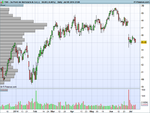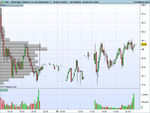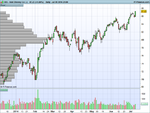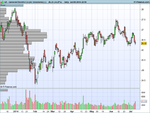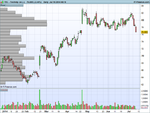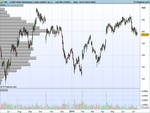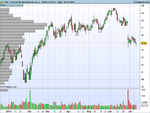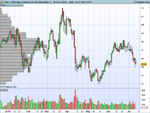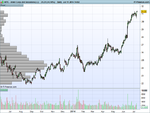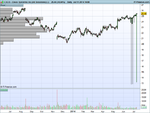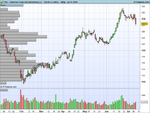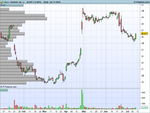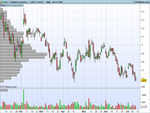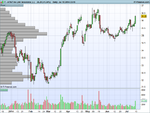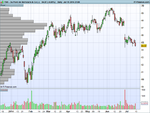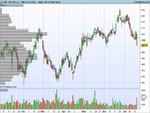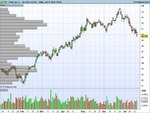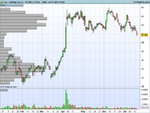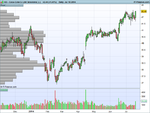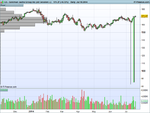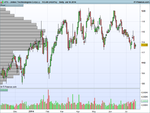... You are right that I lack consistency in how I close winning positions. This is because I haven't really worked out what my philosophy is on this.
With a losing position, I have a method which makes sense to me and which conforms to standard trading wisdom. i.e cut your losses. I apply this in practice by, first, having a "safety" stop loss but also assessing each open position at the end of the day. Is this a trade that I would enter into now?or in other words,does the set up still work? If not, I close it. Simple.
But I feel a conflict with winning positions. Let your profits run, right? Yes, but what if the set up isn't one that I would enter NOW? Am I not better off closing the position, taking my profit and redeploying my capital in a trade that I do want to enter now?
In reality, I tend to close positions at the end of the day. I can always enter them again tomorrow...
I don't know but it was one way to resolve my indecision over whether to take my profit or let my profits run...
Hi, atters88,
Based off the comments you posted previously above, it is clear that you are at least aware of your ongoing internal trading conflicts (and possibly inner values conflicts) with regards to targets/profit-taking. Awareness is a critical step towards curiosity, interest, growth, learning, knowledge, application, wisdom! :clap:
I'd like to suggest that you take the time - or make the time - to gather your closed trades and organize it chronologically into a spreadsheet. Then debrief the last 20-30 closed trades and include in the spreadsheet the following:
1. Date of Entry.
2. Entry criteria - why? Wide range? Higher volume? Close at tip?
3. Long or Short.
4. Entry Price.
5. Initial Stop-Loss Price.
6. Date of Exit.
7. Exit criteria - why? Stop-Loss hit? Hit Target? Exited early - why specifically?
8. Exit Price.
9. Emotional response observed after Exit. Happy? Excited? Angry? Frustrated?
10. Return/Risk = [(4)-(8)]/[(4)-(5)]
11. $ Size of trade taken.
12. % of trade taken vs account size.
13. Final acct $ balance after closed trade.
Atters88 - it may seem lot a great deal of "homework" - but it will be a very useful learning/growth skill-based exercise for you! :whistling
Remember - it must be the last 20-30 closed CONSECUTIVE trades.
IF - you provide the above "homework" in precision, correct details, etc - I will help provide for you a detailed debriefing analysis for you to review and study and learn to improve your trading rules!
👍
Trading is all about making $$$ consistently - every day, every week, every month (whatever time periodicity you trade with). This requires 100% focus on making the best trading decisions effectively! Beyond this, it requires that you have a working KNOWLEDGE of what is your trading EDGE.
Note = I always emphasize reviewing your trading EDGE every 20-30 closed trades. Professional traders do not react on the basis of one or a couple of losing trades. We use closed trade windows. As your experience and closed trades are documented - we increase the debriefing window to include systematic debriefs at 20-30 closed trades, at 50-60 closed trades, at 80-90 closed trades, etc.
All of the hard data that are true, clean, error-free, honest, will help you to formulate a much stronger base to begin to add the topic of bet-sizing.
Trading is a thinking game! Thinking requires 100% focus, attention to details, precision results/data feedback. Then proper actions with adjustments to get improved data feedback - and ultimately reach your trading destination!
👍
Whenever I've worked with trading interns/clerks/newbies, one of the first skill sets to learn to achieve is so simple = to earn $25 or $50 per day for at least 20 consecutive days! Whatever trading plan/bias is selected, whatever trading asset(s) is used, etc. FX, binary options, standard options, stocks, daytrading, etc.
Learning to achieve profitability = this is done thru actual live trading with $$$ at risk (even if only $25 risk per trade or less). Paper trading is beneficial to a certain level. Paper trading helps to drill down specific trading-platform procedural details, remove random errors of execution, remove basic errors of trading plan execution. However - real trader growth - is achieved only with the real trading $$$ profit or loss outcomes! No way to get around the $$$ barriers that are so emotionally and psychologically "intense/volatile" within us!
😈
No matter what obstacles/challenges exist or arise - if that trading intern can learn to make $25 or $50 per day - every day for 20 consecutive trading days - then he/she will have a very good chance to really become an outstanding trader - with the caveat that he/she is continually monitored for risk management, trading errors, systematic debriefs, etc. :smart:
Can you achieve this trading minimum threshold of performance with your trading plan? How can you know? Well - it will never happen - you will never know - until and unless you begin to TAKE ACTION and STANDARDS at the professional level.
In conclusion - do your homework please. Gather, organize, data for the spreadsheet above! No judgments, no "good" or "bad" atters88!
😕
Only correct accurate vs inaccurate trading data/results to study and debrief.
Good luck - please - enjoy the work and effort! You are investing in yourself. All of the work and effort = conditioning and reinforcing of good trading behaviors! Feel free to ask your questions if you run into internal/psychological barriers. :idea::idea:
Best regards and apologies for the lengthy reply,
WklyOptions

